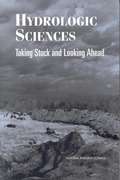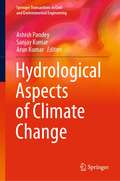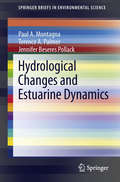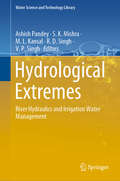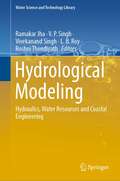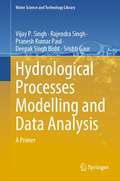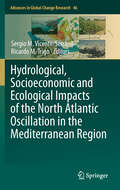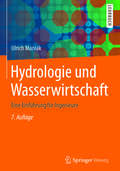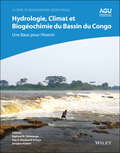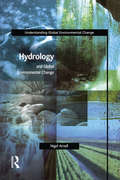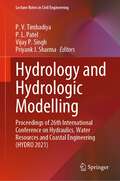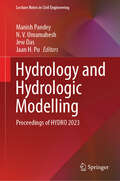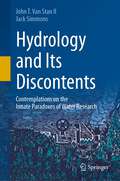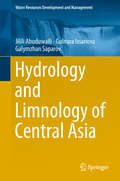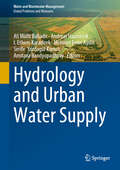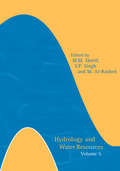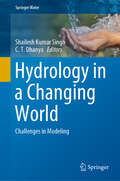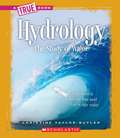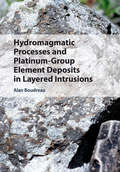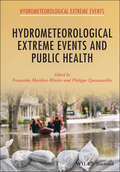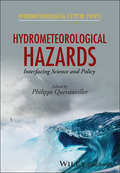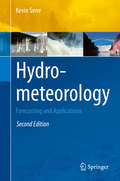- Table View
- List View
Hydrologic Sciences: Taking Stock and Looking Ahead
by Proceedings of the 1997 Abel Wolman Distinguished Lecture Symposium on the Hydrologic SciencesHydrologic science, an important, interdisciplinary science dealing with the occurrence, distribution, and properties of water on Earth, is key to understanding and resolving many contemporary, large-scale environmental issues. The Water Science and Technology Board used the opportunity of its 1997 Abel Wolman Distinguished Lecture to assess the vitality of the hydrologic sciences by the hydrologic community. The format included focus by lecturer Thomas Dunne on the intellectual vitality of the hydrologic sciences, followed by a symposium featuring several invited papers and discussions.Hydrologic Sciences is a compilation of the Wolman Lecture and the papers, preceded by a summarizing overview. The volume stresses a number of needs for furtherance of hydrologic science, including development of a coherent body of transferable theory and an intellectual center for the science, communication across multiple geo- and environmental science disciplines, appropriate measurements and observations, and provision of central guidance for the field.
Hydrological Aspects of Climate Change (Springer Transactions in Civil and Environmental Engineering)
by Sanjay Kumar Arun Kumar Ashish PandeyThis volume arises from the work of Roorkee Water Conclave 2020 and focuses on the hydrological aspects of climate change, hydrological extremes, and adaptation for water resources management. The research papers in this book are centred on themes such as climate change and water security, water resources management, and adaptation to climate change. This volume contains chapters on historical purview of the developments in water management, policy issues, latest development in sustainable water management including their practical applications, real time adverse impact on climate, and more. This volume will be useful to students, researchers as well as practitioners.
Hydrological Changes and Estuarine Dynamics
by Paul Montagna Terence A. Palmer Jennifer Beseres PollackWater development projects have altered the environmental flow landscapes where dams and diversions have been built, and this could have effects on coastal resources, particularly in estuaries. Water is an important human resource and water needs grow as populations grow. However, freshwater inflow to the coast is fundamental to the functioning of estuaries. Can we have stable, secure, and sufficient water resources for people and still protect estuarine health? Estuaries are the most productive environments on Earth, and this is in part due to freshwater inflow, which dilutes marine water, and transports nutrients and sediments to the coast. Estuaries are characterized by salinity and nutrient gradients, which are important in regulating many biological processes. As water is diverted for human consumption, it is common for many environmental problems to appear. While many countries have water quality programs, few are dealing with water quantity alterations. The first step is to define marine resources to protect, and the water quality conditions those resources need to thrive. The second step is to determine the flow regimes needed to maintain the desired water quality conditions. Finally, many regions are using adaptive management programs to manage freshwater resources. These programs set goals to protect ecosystem resources, identify indicators, and monitor the indicators over time to ensure that the goals are appropriate and resources are protected. Case studies demonstrate that monitoring and research can determine the ecological and socio-economical impacts of altered freshwater inflows, and stakeholders and managers can make well-informed decisions to manage freshwater inflows to local coasts wisely.
Hydrological Data Driven Modelling
by Jimson Mathew Renji RemesanThis book explores a new realm in data-based modeling with applications to hydrology. Pursuing a case study approach, it presents a rigorous evaluation of state-of-the-art input selection methods on the basis of detailed and comprehensive experimentation and comparative studies that employ emerging hybrid techniques for modeling and analysis. Advanced computing offers a range of new options for hydrologic modeling with the help of mathematical and data-based approaches like wavelets, neural networks, fuzzy logic, and support vector machines. Recently machine learning/artificial intelligence techniques have come to be used for time series modeling. However, though initial studies have shown this approach to be effective, there are still concerns about their accuracy and ability to make predictions on a selected input space.
Hydrological Extremes: River Hydraulics and Irrigation Water Management (Water Science and Technology Library #97)
by V. P. Singh Ashish Pandey S. K. Mishra M. L. Kansal R. D. SinghThis book presents quality technical papers representing the recent developments in the field of hydrological modeling, water management and water governance including practical applications. The content covers multifarious aspects of hydrology and water resources. It includes an application of the Hydrologic Modelling System (HEC-HMS) which has been successfully demonstrated for assessment of floods. The authors suggest an approach for the mitigation of cyclone disaster through a case study of the Phailin cyclone, whilst considering mitigating pluvial flooding, developing suitable management strategies. The book includes chapters discussing the detrended fluctuation analysis which is carried out for multifractal description of droughts. Drought characteristics are analyzed, and drought indices evolved for drought preparedness/management. The use of science in community planning under changing climate is also studied and discussed. The authors present and experimental study wherein hydraulic coefficients are calibrated by using vertical orifice. A cross flow hybrid hydrokinetic turbine is also evaluated for performance, and high head regulating radial gate designed and studied its sensitivity.This book will appeal to researchers, field practitioners, NGO and other Governmental as well as private water practitioners
Hydrological Modeling: Hydraulics, Water Resources and Coastal Engineering (Water Science and Technology Library #109)
by V. P. Singh Ramakar Jha Vivekanand Singh L. B. Roy Roshni ThendiyathThis book carefully considers hydrological models which are essential for predicting floods, droughts, soil moisture estimation, land use change detection, geomorphology and water structures. The book highlights recent advances in the area of hydrological modelling in the Ganga Basin and other internationally important river basins. The impact of climate change on water resources is a global concern. Water resources in many countries are already stressed, and climate change along with burgeoning population, rising standard of living and increasing demand are adding to the stress. Furthermore, river basins are becoming less resilient to climatic vagaries. Fundamental to addressing these issues is hydrological modelling which is covered in this book. Integrated water resources management is vital to ensure water and food security. Integral to the management is groundwater and solute transport, and this book encompasses tools that will be useful to mitigate the adverse consequences of natural disasters.
Hydrological Processes Modelling and Data Analysis: A Primer (Water Science and Technology Library #127)
by Rajendra Singh Vijay P. Singh Deepak Singh Bisht Pranesh Kumar Paul Srishti GaurThis book provides a state-of-the-art overview of the concepts and methodologies of data and modelling-driven hydrological analyses and their wide range of practical applications. The book is driven by the realisation that science, technology, engineering, and mathematics (STEM) concepts are essential in engineering hydrology to produce well-trained hydrologists. Such hydrologists will be equipped to face future societal challenges that require enhanced information and communication technology tools and integration of technical and non-technical areas. The book contains 12 chapters that introduce the principles of hydrological data analysis and highlight the current and emerging tools and techniques for analysing hydrologic data. The book describes the types of data typically used in hydrological analyses. It highlights the revolutionary technological advancements made toward hydrological data collection, including the use of drones and smartphones. The foremost objective of the book is to present the hydrological data analysis procedures. It explains the steps involved in data analysis for easy understanding of the reader, including students and professionals. This book presents case studies that demonstrate step-by-step procedures involved in typical analysis problems and may guide students and professionals in planning and executing steps to analyse the problem at hand. Case study examples will guide them to understand the intricacies of hydrological data analysis. It provides the readers with a complete package to enrich their understanding of the hydrological data analysis tools and techniques. Subsequently, as well-trained hydrologists, they could execute their learning to meet any specific grand challenge of the twenty-first century.
Hydrological Processes of the Danube River Basin
by Mitja BrillyThe Danube River Basin is shared by 19 countries and there is no river basin in the world shared by so many nations. Covering an area of about 800,000 km², it is Europe's second largest river basin and home to 83 million people of different cultures, languages and historical backgrounds. Management of common water sources and overcoming difficulties caused by droughts and floods requires co-operation between these countries. In the past twenty years political turbulence has caused an increase in the number of countries included, making co-operation difficult at times. Nevertheless several projects were launched and a number of reports were produced. In 2008, at the 22nd Working Meeting of the Regional Hydrological Co-operation of the Danube Countries in the framework of IHP/UNESCO at the XXIVth Conference of the Danubian Countries, it was decided that these reports would be summarised in one special publication. It was also agreed to include additional reports serving the common interest. This publication therefore brings together the reports and papers related to regional co-operation. It is the result of a major collaboration and examines a broad range of topics. These include hydrological forecasting and hydro-meteorological extremes, global climate change and hydrological processes, water management, and developments in hydrology. The book includes the efforts of many hydrologists and technical staff from different Universities and Agencies from all countries of the Danube River Basin.
Hydrological, Socioeconomic and Ecological Impacts of the North Atlantic Oscillation in the Mediterranean Region
by Sergio M. Vicente-Serrano Ricardo M. TrigoThe Mediterranean basin represents one of the most important "hot spots" of climate change in the world, with recent trends towards a hotter and drier climate being related to changes in atmospheric circulation patterns. Such changes can have significant impacts in the climate of this region but also on the natural environment and several socioeconomic activities. Among these patterns, the North Atlantic Oscillation (NAO) is one of the main forcing factors in the region with impact on extreme events such as droughts, severe precipitations or heat and cold waves, the availability of water resources, the ecological dynamics, the quality and quantity of crops, the migration and welfare of animal populations, the fisheries dynamics, the triggering of landslides and the air pollution and human health, among others. The aim of Hydrological, Socioeconomic and Ecological Impacts of the North Atlantic Oscillation in the Mediterranean Region, is to serve as an updated reference text that covers the wide range of evidences on the NAO impacts in the Mediterranean regions and from a multidisciplinary perspective. This volume constitutes a unique document to present the state of the art of the numerous studies undertaken on the hydrological, socioeconomic and ecological impact of the NAO, collecting the expertise of researchers from several complementary earth science fields (geography, hydrology, remote-sensing, climatology, agriculture, energy), but that have been lacking a common ground.
Hydrologie und Wasserwirtschaft: Eine Einführung für Ingenieure (Springer-Lehrbuch)
by Ulrich ManiakDie aktualisierte und #65533;berarbeitete 7. Auflage des FachbuchsHydrologie und Wasserwirtschaft beschreibt hydrologische Grundlagen undL#65533;sungsans#65533;tze f#65533;r Aufgaben in der Wassermengen- und -g#65533;tewirtschaft und imGew#65533;sserschutz. Erweitert wurden die Verfahren der Abflussermittlung undDatenverarbeitung sowie die Ermittlung von Bemessungswerten f#65533;r Wasserbautenund ihren Betrieb mit Flussgebietsmodellen, auch unter Einfluss desKlimawandels, der Risikobetrachtungen f#65533;r ihr Versagen und derDurchflussvorhersage. Erg#65533;nzt wurden Stoffbilanz- und -transportmodelle zurPrognose der Gew#65533;sserg#65533;te bei Sanierungsma#65533;nahmen. Die Interpretation derErgebnisse wird durch zahlreiche Praxisbeispiele veranschaulicht. Die Neuauflageist ein unverzichtbares Arbeitsbuch, genau und aktuell auf die Praxis desIngenieurs zugeschnitten.
Hydrologie, climat et biogeochimie du bassin du Congo: Une Base pour l'Avenir (Geophysical Monograph Series)
by Raphael M. Tshimanga Guy D. Moukandi N’kaya Douglas AlsdorfLA SÉRIE DE MONOGRAPHIE GÉOPHYSIQUE Hydrologie, Climat et Biogéochimie du Bassin du Congo Une Base pour l’Avenir Le Congo est le deuxième plus grand bassin fluvial du monde et abrite 120 millions d’habitants. La compréhension du cycle de l’eau, des sédiments et des nutriments est importante car la région est confrontée à des changements climatiques et anthropiques. Hydrologie, Climat et Biogéochimie du Bassin du Congo : Une Base pour l’Avenir explore les variations et les influences sur les précipitations, l’hydrologie et l’hydraulique, et la dynamique des sédiments et du carbone. Il présente des contributions d’experts de la région et de leurs collaborateurs internationaux. Les points forts du volume comprennent: Nouvelles mesures in situ et par télédétection et les résultats des modèles Utilisation des données historiques pour évaluer les précipitations et les changements hydrologiques Exploration des échanges d’eau entre les zones humides et les rivières Processus biogéochimiques dans les forêts et les zones humides du bassin du Congo Une base scientifique pour la gestion des ressources hydrologiques dans la région Études de différentes parties du fleuve Congo et de ses bassins adjacents Ce livre est également disponible en anglais. L’Union Géophysique Américaine encourage la découverte des sciences de la Terre et de l’espace au profit de l’humanité. Ses publications diffusent des connaissances scientifiques et fournissent des ressources aux chercheurs, aux étudiants et aux professionnels.
Hydrology
by Wilfried BrutsaertWater in its different forms has always been a source of wonder, curiosity, and practical concern for humans everywhere. This textbook presents a coherent introduction to many of the concepts and relationships needed to describe the distribution and transport of water in the natural environment.
Hydrology and Global Environmental Change (Understanding Global Environmental Change)
by Nigel W. ArnellHydrology and Global Environmental Change presents the hydrological contribution to, and consequences of, global environmental change. Assuming little or no prior knowledge on the part of the reader, the book looks at the main processes of global environmental change - global scale processes, large regional processes, repetitive processes - and how the hydrological cycle, processes and regimes impact on GEC and vice-versa.
Hydrology and Hydrologic Modelling: Proceedings of 26th International Conference on Hydraulics, Water Resources and Coastal Engineering (HYDRO 2021) (Lecture Notes in Civil Engineering #312)
by Vijay P. Singh P. V. Timbadiya Priyank J. Sharma P. L. PatelThis book comprises the proceedings of the 26th International Conference on Hydraulics, Water Resources and Coastal Engineering (HYDRO 2021) focusing on broad spectrum of emerging opportunities and challenges in the field of hydrology and hydrological modelling. It covers a range of topics, including, but not limited to, ground water modelling and management, integrated water resources and watershed management, surface water hydrology, drought assessment and mitigation, risk, reliability and design of hydrologic system, etc. Presenting recent advances in the form of illustrations, tables, and text, it offers readers insights for their own research. In addition, the book addresses fundamental concepts and studies in the field of hydrology and hydrological modelling, making it a valuable resource for both beginners and researchers wanting to further their understanding of hydraulics, water resources and coastal engineering.
Hydrology and Hydrologic Modelling: Proceedings of HYDRO 2023 (Lecture Notes in Civil Engineering #410)
by Manish Pandey Jaan H. Pu N. V. Umamahesh Jew DasThis book comprises proceedings of the 28th International Conference on Hydraulics, Water Resources, River and Coastal Engineering (HYDRO 2023). It focuses on emerging opportunities and challenges in the field of hydrology and hydrological modelling. The book covers a range of topics including, but not limited to, groundwater modelling and management, integrated water resources and watershed management, surface water hydrology, drought assessment and mitigation, risk, reliability and design of hydrologic systems. The book presents these topics in the form of illustrations and tables, thereby providing the readers with an in-depth insight into the recent research. It also addresses fundamental concepts and studies in the field of hydrology and hydrological modelling, making it a valuable resource for researchers and professionals working in the fields of hydraulics, water resources and coastal engineering.
Hydrology and Its Discontents: Contemplations on the Innate Paradoxes of Water Research
by Jack Simmons John T. Van Stan IIThis book examines the intricate web linking water science and society using diverse philosophical lenses. Highlighting the tensions within the threads of this web, we spotlight major conceptual tightropes that water researchers tread daily. To effectively navigate these delicate threads, a 'healthy' tension in the encompassing web is necessary. Drawing inspiration from Freud's examination of tensions in "Society and Its Discontents," we illuminate the tension-filled paradoxes inherent to water science, emphasizing the challenges in keeping these paradoxical threads taut enough to ensure a navigable and sustainable bond with society. Central to our narrative is the escalating societal urge to quantify and 'manage' water—something interwoven throughout every environmental layer, including the fabric of our being. An excessive focus on management may alienate users from their water realities, jeopardizing the vital threads that sustainability tether water science and society. Consequently, this book explores compelling and inescapable tensions that resist tidy universal resolution, such as: the language of water science, including its mathematical reductions (i.e., models); the effect of water's commodification on its science; hydrology’s intersection with colonialism; and other concerns that reveal distortions in our hydrology. We aim to aid water professionals in recognizing and fine-tuning the paradoxes intrinsic to their work. To underscore the interwoven complexity of contemporary hydrology, "Hydrology and Its Discontents" guides readers into the tempestuous depths of water research, all the while urging a recalibration of perspectives and motivations.
Hydrology and Limnology of Central Asia (Water Resources Development and Management)
by Gulnura Issanova Jilili Abuduwaili Galymzhan SaparovThis book highlights the development of lake systems and water reservoirs as well as the impact of climate change on water resources in Central Asian countries. It provides information on the genesis of lake basins, physical and chemical properties of water in lakes, and the hydrological regimes (water balance and fluctuation levels) of lakes of Central Asia and Xinjiang. The book is useful for scientists and researchers whose work focuses on lakes and the use of natural resources, irrigation, hydropower and water supply, as well as for students and planners.
Hydrology and Urban Water Supply (Water and Wastewater Management)
by Amitava Bandyopadhyay Andreas Haarstrick Ali Müfit Bahadir I. Ethem Karadirek Mehmet Emin Aydin Serife Yurdagül KumcuThis book explores the intricate relationship between hydrology and urban water provision. Authored by experts in the field, this book offers a comprehensive exploration of the challenges and solutions associated with urban water supply management in the context of hydrology. It covers topics such as water sources, treatment technologies, distribution systems, and sustainable water management practices. With its meticulous analysis and practical insights, this book equips professionals, researchers, and policymakers with the knowledge necessary to address the growing demands of urban water supply in an era of climate change and urbanization.
Hydrology and Water Resources: Volume 5- Additional Volume International Conference on Water Resources Management in Arid Regions, 23-27 March 2002, Kuwait
by Boca RatonThis is the fifth and last volume representing the proceedings of the International Conference on Water Resources Management in Arid Regions held March 23rd-27th 2002 in Kuwait. This book discusses major aspects of hydrology and water resources. It presents papers on important aspects of surface water and groundwater hydrology, including drought tendencies, regional flood frequency analysis, urban storm drainage with curb-opening inlets, isotopic investigations for lakes, hydrologic and sediment transport modeling, groundwater exploration using remote sensing and GIS, origin and recharge rates of alluvial ground waters, stormwater and groundwater management, and considerations for stochastic finite element in geostatistics and modeling. Papers on water quality supplement the discussion.
Hydrology in a Changing World: Challenges in Modeling (Springer Water)
by Shailesh Kumar Singh C. T. DhanyaThis book offers a comprehensive overview of the challenges in hydrological modeling. Hydrology, on both a local and global scale, has undergone dramatic changes, largely due to variations in climate, population growth and the associated land-use and land-cover changes. Written by experts in the field, the book provides decision-makers with a better understanding of the science, impacts, and consequences of these climate and land-use changes on hydrology. Further, offering insights into how the changing behavior of hydrological processes, related uncertainties and their evolution affect the modeling process, it is of interest for all researchers and practitioners using hydrological modeling.
Hydromagmatic Processes and Platinum-Group Element Deposits in Layered Intrusions
by Alan BoudreauThe role of hydrothermal fluids during the crystallization of layered intrusions and the ore deposits they contain has long been debated. This book summarizes the evidence for fluid-crystal-liquid (hydromagmatic) interactions and their importance for the understanding of the formation of platinum-group deposits in layered intrusions. It discusses the composition of igneous fluids in mafic magmatic systems, the generation and movement of these fluids in layered intrusions, their impact in altering the mineralogy and composition of the originally precipitated assemblages, and their role in the transport of the platinum-group elements (PGE). Using examples from the Bushveld complex of South Africa and other intrusions, this book provides a comprehensive overview of the hydromagmatic model for the origin of various features of layered intrusions. It is a useful reference for academic researchers and professional geologists working on economic mineral exploration, layered igneous intrusions, and hydrothermal metallogenesis.
Hydrometeorological Extreme Events and Public Health (Hydrometeorological Extreme Events)
by Philippe Quevauviller Franziska Matthies-WieslerHYDROMETEOROLOGICAL EXTREME EVENTS AND PUBLIC HEALTHs p>CONTINGENCY PLANNING FOR INCREASED FLOODS AND DROUGHTS RESULTING FROM CLIMATE CHANGE TO PROTECT HUMAN HEALTH Hydrometeorological Extreme Events and Public Health outlines the links between climate change, trends in hydrometeorological extreme events, and the effects on human health, and describes new developments in health adaptation and disaster risk management. The work provides technical facts, examples of international and national approaches and scientific projects, and covers key issues such as multi-sectoral collaboration, disaster preparedness, response and recovery, as well as stakeholder involvement, and costs. Readers will find: Specific observed and projected health effects of heavy precipitation events, floods, and droughts A comprehensive analysis of recent studies on the health costs of extreme weather events A discussion of the impact and interdependency of international health and climate agreements For professionals working in the areas of hydrology, disaster management and prevention, and in the public health sector, Hydrometeorological Extreme Events and Public Health serves as a comprehensive resource on new challenges resulting from climate change and on how we can plan for and adapt to this uncharted territory to protect human lives and human health. The book is the fifth volume of the Hydrometeorological Extreme Events Series.
Hydrometeorological Hazards: Interfacing Science and Policy (Hydrometeorological Extreme Events)
by Philippe QuevauvillerRecent hydrometeorological extreme events have highlighted the increased exposure and vulnerability of societies and the need to strengthen the knowledge-base of related policies. Current research is focused on improving forecasting, prediction and early warning capabilities in order to improve the assessment of vulnerability and risks linked to extreme climatic events. Hydrometeorological Hazards: Interfacing science and policy is the first volume of a series which will gather scientific and policy-related knowledge related to climate-related extreme events. Invited authors are internationally recognized experts in their respective fields. This volume reflects the most recent advances in science and policy within this field and takes a multidisciplinary approach. The book provides the reader with a state-of-the art account on flash floods, droughts, storms, and a comprehensive discussion focused on the cost of natural hazards, resilience and adaptation. This book will be an invaluable reference for advanced undergraduates taking courses with a focus on natural hazards including climate-related extreme events. The book will also be of interest to postgraduates, researchers and policy makers in this field looking for an overview of the subject.
Hydrometeorology
by Kevin SeneThis book describes recent developments in hydrometeorological forecasting techniques for a range of timescales, from short term to seasonal and longer terms. Following an introduction to measurement and modelling techniques, subsequent chapters discuss a range of practical applications in flood and drought forecasting, climate change and environmental impact assessments, water resources and water quality studies, agriculture, hydropower, river basin management. The book is useful for civil engineering, water resources, meteorology and hydrology courses for post-graduate students, but is primarily intended as a state-of-the-art review for a wider audience. Kevin Sene is a civil engineer and researcher with wide experience in flood forecasting, water resources and hydrometeorological studies. He has published some 45 scientific and conference papers on topics in hydrology, hydrometeorology and hydraulics.
